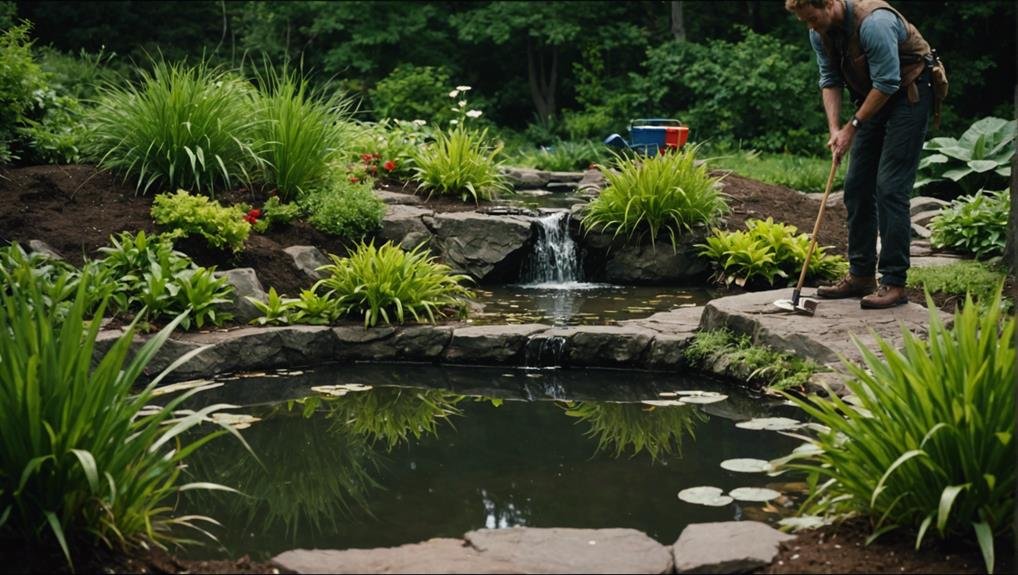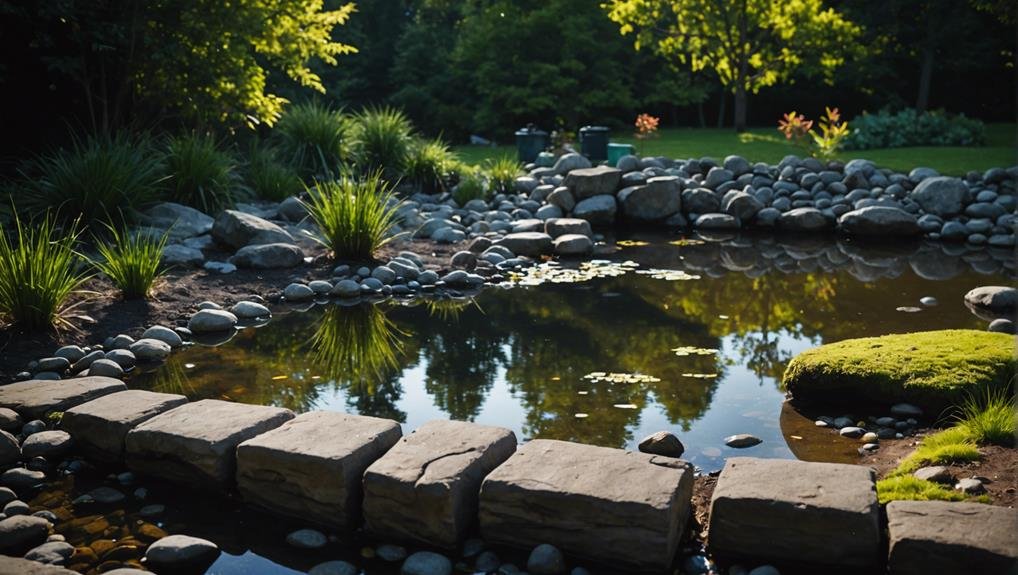When embarking on DIY pond repairs, it's crucial to steer clear of common pitfalls to ensure a successful outcome.
Selecting an unsuitable location, like low-lying areas, can result in water quality issues.
It's important to not underestimate the amount of labor required for tasks such as excavation and rock placement, as this can make the project more challenging than anticipated.
Opting for steep sides can pose risks and hinder maintenance efforts, while shallow ponds may cause stress to fish due to temperature fluctuations.
Additionally, using rocks improperly can compromise the stability and overall aesthetics of the pond.
Careful planning of each step is essential to creating a functional and visually appealing pond.
By considering these factors, we can enhance our pond project with essential details.
Poor Location Choices
Picking the right location for our pond is crucial to avoid water quality issues and runoff problems. Placing the pond in low-lying areas can result in the accumulation of polluted runoff, harming the water quality. Additionally, high water tables in these areas can lead to poor water conditions, making maintenance challenging.
To prevent these issues, it's essential to choose an optimal location for our pond. Placing it near the house enhances visibility and accessibility, making it easier to enjoy and care for. Having the pond close to patios or decks is also beneficial, as it allows us to maximize our pond experience without long walks.
Addressing runoff problems is another important consideration. Ensuring that the pond is positioned to minimize runoff and pollutants is key. This may involve grading the surrounding area or installing barriers to redirect water flow.
Underestimating Labor
When choosing the best spot for our pond, it's crucial to also consider the physical work involved in DIY pond repairs. Underestimating the amount of labor needed can lead to inefficient repairs and unsuccessful outcomes. Tasks like digging and heavy lifting are physically demanding and often require more effort than we initially think. Recognizing these labor requirements is essential to prevent exhaustion and project delays.
When planning our DIY pond repairs, it's important to keep in mind the following factors:
- Digging: Excavating a pond without proper tools can be very strenuous.
- Heavy Lifting: Moving rocks, soil, and other materials requires significant strength.
- Extra Help: Having additional assistance can make the process smoother and faster.
- Detailed Planning: Planning out the tasks in advance can help allocate labor more effectively.
- Taking Breaks: Regular breaks are important to avoid overexertion and improve productivity.
Underestimating the labor involved can lead to incomplete repairs or harm the pond's ecosystem. Understanding the physical work required and planning accordingly is key to achieving successful results.
It's not just about the initial effort; ongoing maintenance also demands a realistic assessment of our physical abilities. By acknowledging the labor demands upfront, we can ensure that our DIY pond project is manageable and yields positive outcomes.
Steep Sides

Having steep sides in ponds can make maintenance a challenging and risky task. It becomes difficult to access and perform regular upkeep or address any issues that may arise. The absence of shallow areas in deep-sided ponds hinders plant growth and stability, as aquatic plants require proper ledges to thrive. This imbalance in the ecosystem complicates DIY pond repairs more than expected.
Deep pits without adequate ledges also present maintenance challenges and safety risks. Steep slopes not only make it hard to reach different parts of the pond but also increase the risk of slipping and falling into the water.
Furthermore, the lack of proper ledges affects the overall functionality of the pond by making it difficult for aquatic plants to establish themselves, leading to further imbalance in the ecosystem.
Shallow Ponds
When it comes to shallow ponds, there are specific challenges that DIY enthusiasts should be aware of. A major issue is the fluctuating water temperature in shallow areas, which can stress fish and even lead to their death, especially in colder regions where freezing is a concern. In warmer climates, shallow ponds are at risk of overheating, leading to rapid algae growth that can harm the pond ecosystem.
Maintaining an appropriate depth is crucial for the well-being of fish and the overall health of the pond. Deeper ponds, with a depth of at least 24 inches, offer a more stable environment, reducing the likelihood of temperature fluctuations and algae problems. Shallow ponds require more frequent attention and care to ensure a balanced ecosystem.
Some key considerations for shallow ponds include the rapid temperature changes, the impact on fish health, the potential for algae overgrowth, the importance of maintaining a minimum depth of 24 inches, and the need for regular maintenance to manage water quality and algae growth.
To address these challenges, DIY pond enthusiasts may consider using shading techniques, installing aeration systems, incorporating aquatic plants to provide shade and oxygen, and regularly monitoring water parameters to ensure a healthy pond environment. By taking these proactive steps, shallow ponds can thrive and support a diverse range of aquatic life.
Improper Rock Use

Using the right rocks is crucial in pond construction to maintain stability and enhance the pond's beauty. Opting for small rocks over larger ones can compromise the pond's structure and natural appearance. While small rocks may seem easier for DIY repairs, they lack the necessary balance for a stable pond.
Properly positioned rocks are vital for stability and creating a habitat for aquatic life. These rocks play a key role in supporting the ecosystem, ensuring the well-being of plants and animals. Mixing rocks of various sizes helps achieve a more natural and visually appealing design.
Consider the impact of rock size on pond construction:
- Small Rocks: Low structural integrity, poor aesthetic appeal, minimal habitat for aquatic organisms.
- Medium Rocks: Moderate structural integrity, average aesthetic appeal, sufficient habitat for aquatic organisms.
- Large Rocks: High structural integrity, excellent aesthetic appeal, optimal habitat for aquatic organisms.
Balancing aesthetics and functionality is essential when choosing rocks for pond construction. Selecting the right rocks not only enhances the pond's visual appeal but also fosters a healthy ecosystem.
Proper rock placement is key to creating a pond that's both attractive and resilient.
Aesthetic Compromises
When embarking on DIY pond repairs, it's crucial to consider the impact on the pond's visual appeal. One common oversight is the selection of stones and rocks. Using rocks that are either too big or too small can throw off the pond's balance and make it look unnatural.
Properly placing stones is key to maintaining a natural aesthetic and avoiding an unattractive appearance.
To ensure your pond remains visually pleasing, it's important to choose rocks of the right size, avoid mixing different rock types excessively, strategically place the rocks, create visual harmony with the surrounding landscape, and prevent overcrowding.
Conclusion
In wrapping up, tackling DIY pond repairs can be a bit like navigating a maze. We've all been guilty of choosing the wrong spot or underestimating the work involved—it's like trying to force a square peg into a round hole.
Keep in mind that ponds with steep sides or that are too shallow can lead to instability and poor water quality. Using rocks improperly and making compromises on aesthetics are common pitfalls that many DIYers encounter.
By being aware of these mistakes, we can build ponds that not only look beautiful but also function well for years to come.

